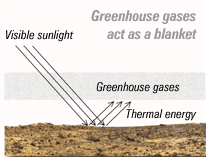|
Artificial greenhouse gases that are bad
news on Earth could provide the means to make Mars a more comfortable
place for humans to live.
by Dr Tony Philips
To say that Mars is a chilly place
would be an understatement. The Red Planet's mean annual temperature
is 55 degrees C below zero - that's about the same as the
temperature of Earth's south pole during winter.
If humans ever build communities on
Mars, they might want to find a way to turn up the global thermostat.
At a NASA-sponsored conference, "The
Physics and Biology of Making Mars Habitable", scientists discussed
ways that future colonists might make the frigid planet a little
more comfortable.
One solution might be to pump enough
greenhouse gases into the Martian atmosphere to create a runaway
greenhouse effect. Here on Earth, the idea of a runaway greenhouse
sets off alarm bells. But on Mars it could be a plus. Scientists
at the conference speculated how it might be possible to warm Mars
just enough to evaporate the planet's available carbon dioxide (CO2
trapped in ices and frost) into the atmosphere, where such gases
could contribute to keeping the planet warm.
But there are two problems. First,
even if all of Mars's available CO2 were coaxed into the atmosphere,
it wouldn't necessarily warm the planet enough to make it a comfortable
place for humans, because no one knows just how much CO2 is there.
Second, the best way to get Mars to release its CO2 spontaneously
is, well... to warm it up. It's a "Catch-22" situation!

Sunlight is absorbed by
a planet's surface, which then radiates warming infrared
energy into the atmosphere. Greenhouse gases prevent that
energy from escaping into space.
|
Margarita Marinova,
an undergraduate student at MIT, believes she has an answer to both
problems. Use artificially created perfluorocarbons (PFCs) to initiate
the planetary warming process. Marinova has been studying the warming
effects of PFCs, in collaboration with Chris McKay, a member of the
NASA Astrobiology Institute at the Ames Research Centre. McKay
was one of the organisers of the terraforming conference where Marinova
presented her research.
PFCs have several advantages. First,
they are super-greenhouse gases. A little bit does a lot of warming.
Second, PFCs have a very long lifetime. This causes serious problems
on Earth, but their longevity would be a positive factor on Mars.
Third, they do not have any negative effects on living organisms.
Finally, unlike their chemical cousins,
chlorofluorocarbons (CFCs), PFCs don't deplete ozone. Ozone in Earth's
atmosphere provides protection against ultraviolet (UV) radiation,
which is harmful to life. On Mars, building up an ozone layer in
the atmosphere would be an important goal of terraformers. "You
don't want to destroy ozone," says Marinova, "because it's a UV
protector."
The sunlight that hits a planet's surface
arrives primarily as visible and ultraviolet light. The planet absorbs
this solar energy, and then re-radiates warming infrared energy
back out into the atmosphere. Greenhouse gases in the atmosphere
work as a global layer of insulation, trapping that infrared radiation
and preventing it from escaping into space.
CO2 and water are good at trapping
some of this infrared energy, but not all of it. On Earth, there's
so much CO2 and water in the atmosphere that it doesn't matter if
some infrared radiation escapes back into space.
But on Mars, terraformers will want
to trap every bit of heat they can. A carefully chosen combination
of PFCs could do the job quite handily.
"When we first start warming Mars,"
explains Marinova, "we'll want to cover the whole spectrum" of thermal
infrared radiation. "Once CO2 is released, it will take over" part
of the job, and PFCs will only need to be used to plug the gaps.
An artist's concept of a full-fledged
Martian greenhouse, an essential part of any future human
colony on the Red Planet.
|
And how fast can Mars be heated up?
"That depends," says Marinova, "on
how fast we make the gases." According to rough calculations, "if
you had 100 factories, each having the energy of a nuclear reactor,
working for 100 years, you could warm Mars six to eight degrees."
At that rate, to increase the average Martian temperature to the
melting point of water -- it's about minus 55 degrees Celsius now
-- would take about eight centuries. Actually, it wouldn't take
quite that long, Marinova points out, because her calculation doesn't
include the feedback effect of the CO2 that would be released as
Mars got steadily warmer. "Devising more efficient artificial super-greenhouse
gases will also make it faster," Marinova adds.
Human habitation of Mars is a long
way off. NASA's current plan for exploring the Red Planet, which
spans the next two decades, does not include even a pioneering human
mission to Mars. By the time a permanent settlement is established
there -- one that might begin the task of terraforming the planet
-- technological advances may make it possible to warm its atmosphere
far more efficiently than is possible using the techniques being
studied today by scientists like Marinova.
|
